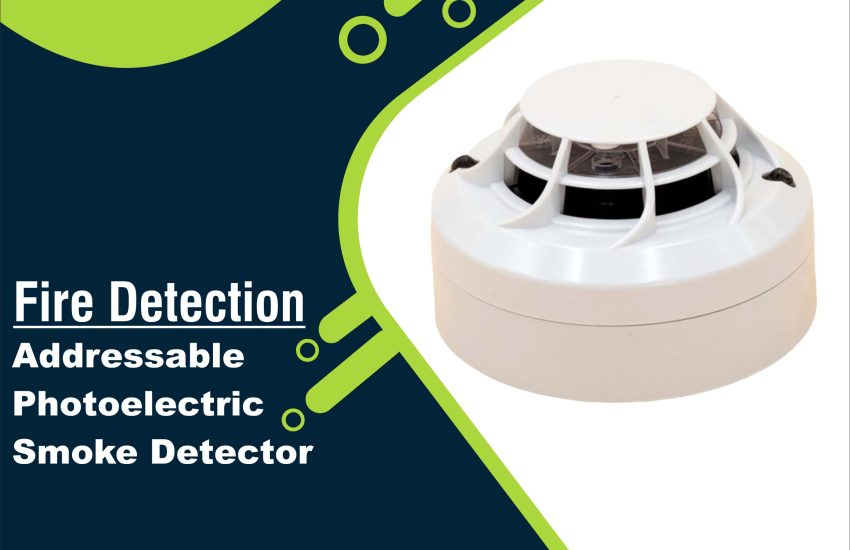Addressable Photoelectric Smoke Detector In modern fire safety systems, Addressable Photoelectric Smoke Detectors play a crucial role in early fire detection. They provide an advanced and efficient solution for both residential and commercial buildings. This comprehensive guide will explain the working mechanism, benefits, features, installation, and maintenance of Addressable Photoelectric Smoke Detectors.
What is an Addressable Photoelectric Smoke Detector?
An Addressable Photoelectric Smoke Detector is a type of smoke detection device that uses light sensing technology (photoelectric sensing) to detect the presence of smoke in a given area. The term “addressable” means that each smoke detector has a unique identifier, allowing the fire alarm control panel to pinpoint the exact location of a smoke event within the building.
These smoke detectors are commonly used in addressable fire alarm systems, offering precise, efficient fire detection in both residential and commercial properties.
How Does an Addressable Photoelectric Smoke Detector Work?
The photoelectric smoke detector works by utilizing a light beam to detect smoke particles. Here’s how it operates:
- Light Source: The detector contains a light source (usually infrared or LED).
- Smoke Detection: When smoke particles enter the sensing chamber, they scatter the light beam.
- Light Sensor: The scattered light hits a sensor, which then detects the light intensity.
- Signal to Control Panel: The detector sends an alarm signal to the fire alarm control panel when smoke is detected. Since it’s an addressable device, the control panel can identify the exact location of the alarm.
Key Features of Addressable Photoelectric Smoke Detectors
- Addressable Technology: Each detector is assigned a unique address, which allows for precise location identification.
- Photoelectric Sensing: The device uses light scattering technology to detect smoke, offering quick and reliable detection, especially in smoldering fires.
- Low False Alarm Rate: Photoelectric detectors are less likely to trigger false alarms compared to ionization detectors.
- Remote Testing and Monitoring: Some addressable smoke detectors support remote testing, maintenance, and monitoring, which enhances system reliability.
- Advanced Sensitivity Settings: The sensitivity of the detectors can often be adjusted to meet specific requirements, reducing unnecessary alerts.
Types of Addressable Smoke Detectors
While there are various types of addressable smoke detectors, the two main categories include:
- Photoelectric Smoke Detectors: These are the most common type used in addressable systems, ideal for detecting smoldering fires.
- Ionization Smoke Detectors: These detectors use ionization technology and are better suited for detecting fast, flaming fires. In addressable systems, both types of detectors can work together, offering comprehensive coverage.
Benefits of Addressable Photoelectric Smoke Detectors
There are several advantages to using Addressable Photoelectric Smoke Detectors in a fire alarm system:
- Precise Location Identification: The most significant benefit of addressable smoke detectors is their ability to pinpoint the exact location of the smoke source, making it easier for first responders to act quickly.
- Improved Reliability: With less chance of false alarms, these detectors provide a higher level of reliability than traditional smoke detectors.
- Cost-Effective: Though slightly more expensive than conventional smoke detectors, the reduced need for system-wide maintenance and false alarm mitigation make them a cost-effective option in the long term.
- Easy Integration: These detectors easily integrate into addressable fire alarm systems, allowing for more flexible, scalable installations in larger buildings.
- Enhanced Safety: By offering earlier and more accurate smoke detection, addressable photoelectric smoke detectors significantly improve building safety.
Installation of Addressable Photoelectric Smoke Detectors
Installing an addressable photoelectric smoke detector involves several important steps. Here’s a general guide for installation:
- Select Appropriate Locations: Ensure that smoke detectors are placed in key areas of the building, such as hallways, near bedrooms, and within any spaces prone to fire hazards.
- Wiring: Install the addressable fire alarm system wiring according to the manufacturer’s guidelines and local codes. Each detector needs to be connected to the fire alarm control panel via a loop or circuit.
- Mounting: Mount the detector on the ceiling or wall as per the manufacturer’s instructions. The device should be installed at the correct height to optimize smoke detection.
- Programming: Once installed, program each detector into the fire alarm control panel. This is necessary to assign each unit a unique address so that the exact location of the alarm can be identified.
- Testing: After installation, conduct thorough testing to ensure that the system is functioning correctly and that each detector is properly communicating with the control panel.
Maintenance of Addressable Photoelectric Smoke Detectors
Regular maintenance is essential to ensure the addressable photoelectric smoke detectors function correctly. Here are some maintenance tips:
- Regular Cleaning: Dust and debris can obstruct the light beam in the detector. Clean the detector periodically using a soft brush or compressed air.
- Test Sensors: Conduct routine tests to verify the detector is responding accurately. Smoke testing kits can simulate smoke and verify detection.
- Check the Control Panel: Regularly check the fire alarm control panel to ensure it’s receiving signals from the detectors and functioning correctly.
- Battery Replacement: If the detectors are battery-powered, ensure the batteries are replaced at least once a year.
- Annual Inspections: Have the system inspected by a professional fire safety technician annually to ensure it complies with fire safety regulations.
Conclusion
Addressable Photoelectric Smoke Detector offer superior fire detection and reliability compared to traditional smoke detectors. Their ability to pinpoint the exact location of a fire event within a building, combined with their low false alarm rate and advanced sensing technology, makes them an essential part of any modern fire alarm system. Whether you’re installing a new addressable fire alarm system or upgrading an existing one, addressable photoelectric smoke detectors provide the peace of mind and safety you need.


